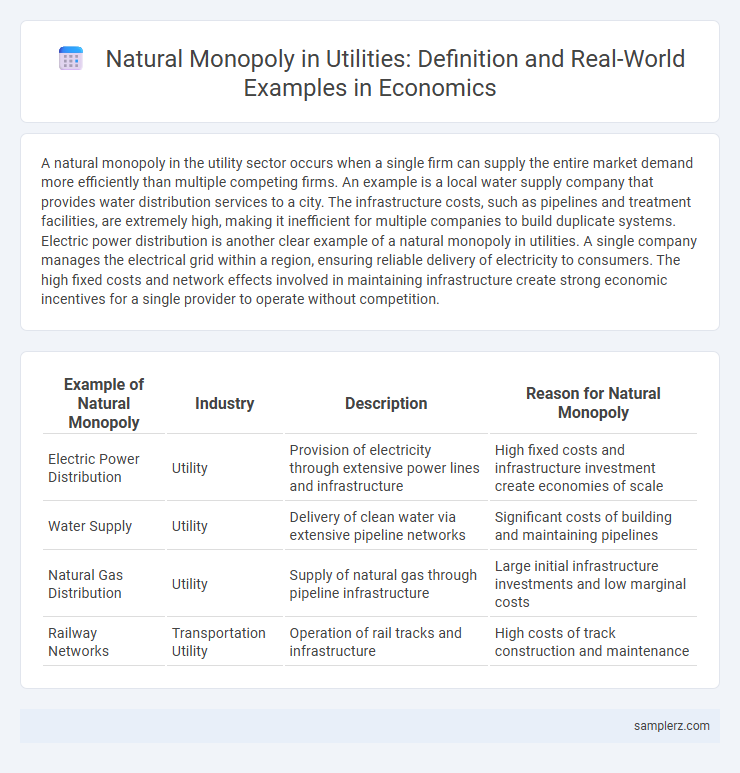A natural monopoly in the utility sector occurs when a single firm can supply the entire market demand more efficiently than multiple competing firms. An example is a local water supply company that provides water distribution services to a city. The infrastructure costs, such as pipelines and treatment facilities, are extremely high, making it inefficient for multiple companies to build duplicate systems. Electric power distribution is another clear example of a natural monopoly in utilities. A single company manages the electrical grid within a region, ensuring reliable delivery of electricity to consumers. The high fixed costs and network effects involved in maintaining infrastructure create strong economic incentives for a single provider to operate without competition.
Table of Comparison
| Example of Natural Monopoly | Industry | Description | Reason for Natural Monopoly |
|---|---|---|---|
| Electric Power Distribution | Utility | Provision of electricity through extensive power lines and infrastructure | High fixed costs and infrastructure investment create economies of scale |
| Water Supply | Utility | Delivery of clean water via extensive pipeline networks | Significant costs of building and maintaining pipelines |
| Natural Gas Distribution | Utility | Supply of natural gas through pipeline infrastructure | Large initial infrastructure investments and low marginal costs |
| Railway Networks | Transportation Utility | Operation of rail tracks and infrastructure | High costs of track construction and maintenance |
Understanding Natural Monopolies in Utilities
A classic example of a natural monopoly in utilities is the electricity distribution network, where the high fixed costs and infrastructure investments make it inefficient for multiple firms to build overlapping systems. The significant economies of scale result in one provider supplying the entire market at a lower cost than competitors could achieve. Understanding natural monopolies in utilities highlights why government regulation or public ownership often ensures fair pricing and reliable service.
Characteristics of Utility-Based Natural Monopolies
Utility-based natural monopolies, such as water supply and electricity distribution companies, exhibit high fixed costs and significant economies of scale that discourage multiple firms from entering the market. These monopolies provide essential services with infrastructure investments so substantial that duplicating the network would be inefficient and economically impractical. Their pricing structures often involve regulated tariffs to balance consumer affordability with cost recovery, reflecting their unique position in the economy.
Why Electricity Distribution Is a Natural Monopoly
Electricity distribution is a natural monopoly because the infrastructure costs of building and maintaining power lines and substations are extremely high, making it inefficient for multiple companies to duplicate the network. The significant economies of scale in distribution ensure that a single provider can supply electricity more cost-effectively than several competing firms. Regulatory frameworks often grant exclusive rights to one company in a region to avoid the wasteful expenditure and complexity of parallel electrical grids.
Water Supply Systems as Classic Natural Monopolies
Water supply systems exemplify classic natural monopolies due to high fixed infrastructure costs and significant economies of scale, making single-provider efficiency greater than multiple competing firms. The extensive network of pipes, treatment facilities, and maintenance required deters market entry, ensuring cost advantages when a sole entity manages distribution. Regulatory frameworks often oversee these monopolies to balance fair pricing with sustainable water resource management.
Natural Gas Networks: Dominance and Distribution
Natural gas networks exemplify a natural monopoly due to the high infrastructure costs and efficiency in centralized distribution systems, making a single provider more cost-effective than multiple competitors. The capital-intensive pipelines and maintenance requirements create substantial barriers to entry, reinforcing the dominant position of incumbent firms. This concentration ensures stable supply and pricing but often necessitates regulatory oversight to prevent market abuse and protect consumer interests.
Rail Transport Infrastructure as a Natural Monopoly
Rail transport infrastructure exemplifies a natural monopoly due to the high fixed costs and significant economies of scale involved in building and maintaining extensive rail networks. These infrastructure investments create substantial barriers to entry, making competition impractical and leading to a single dominant provider in the market. Government regulation often oversees the pricing and access conditions to balance public interest and efficiency in natural monopoly scenarios.
Telecommunications Utilities and Monopoly Trends
Telecommunications utilities often exhibit characteristics of a natural monopoly due to the high infrastructure costs and significant economies of scale in network deployment. Major providers like AT&T and Verizon dominate markets, reducing competitive pressure and creating a barrier for new entrants. Monopoly trends in this sector highlight ongoing challenges in balancing regulation and innovation to ensure affordable access and service quality.
Economic Implications of Natural Monopolies in Utilities
Natural monopolies in utilities, such as electricity distribution by regional power companies, often result in economies of scale that significantly lower average costs compared to multiple competing firms. This market structure can lead to reduced consumer prices but also risks inefficiencies due to lack of competition, necessitating regulatory oversight to prevent price gouging and ensure service quality. Effective regulation balances incentivizing infrastructure investment while protecting consumers from monopolistic exploitation.
Regulation of Utility-Based Natural Monopolies
Utility-based natural monopolies, such as electric power distribution and water supply, require stringent regulatory oversight to prevent pricing abuses and ensure service reliability. Governments or regulatory bodies often impose price caps, set quality standards, and monitor investment levels to balance consumer protection with efficient infrastructure maintenance. Effective regulation fosters fair access while encouraging utilities to optimize operational costs and maintain sustainable service delivery.
Case Studies: Global Examples of Utility Natural Monopolies
Electricity distribution often exemplifies a natural monopoly due to the high infrastructure costs and inefficiencies of duplicating power grids, with utilities like Pacific Gas and Electric in California and Electricite de France (EDF) dominating their markets. Water supply systems in cities such as London, managed by Thames Water, illustrate how centralized infrastructure minimizes costs while maintaining consistent service. These cases demonstrate how regulatory frameworks balance monopoly control with public interest to prevent price gouging and ensure reliable utility access.

example of natural monopoly in utility Infographic
 samplerz.com
samplerz.com